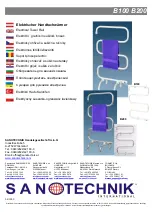
Condensing Models: On-Demand Water Heater Service Handbook • 7
TR
OUBLE
SHOO
TING
TROUBLESHOOTING
Preliminary
Checklist
To get started, review the following
topics. You may also refer to “General
Issues,” if necessary.
Gas/Water/Electric:
•
The gas supply valve should be
fully open and the gas line purged.
•
Verify that the correct gas type
is being used. Check the supply
gas, the gas type dip switch, and
the gas type shown on the rating
plate. All three must agree in
terms of gas type, and your water
heater model must be designed
for use with that type of gas
(natural gas or LP).
•
The water supply valve should be
fully open.
•
The unit should be connected to
a 120 VAC 60 Hz power supply.
When the heater is in Stand By,
the green LED on the computer
board will be lit and the amber
LED on the temperature/remote
controller will be lit.
•
If the power switch inside the
unit is turned off, then the LEDs
mentioned above will be off.
Remote Controller:
If you are using a remote controller,
the remote’s power button must be
turned on. The amber Stand-By LED
will be lit.
High Al tude:
Is your location at an altitude of over 2,000
feet? This may cause a lack of air. See
“Dip Switch Settings,” page 19.
Long Vent Run
Do you have a long vent run? You
may see an unnecessary error due to
back pressure in the venting. See “Dip
Switch Settings,” page 19.
Hard Water:
What is the hardness of the water?
A means of reducing scale is always
recommended, but if the water is
above 7 grains of hardness or 70-
140 ppm, one must be installed. If
there isn’t anything installed, existing
installations will gradually accumulate
scale buildup on the heat exchanger
and cause a leak. Heat exchanger
leaks due to hard water scale are not
covered under the warranty.
New Installa ons:
A new installation that does not
function properly is most likely caused
by reverse plumbing or a dirty inline
water filter.
External Problem:
•
Test whether the problem is
within the unit or external to the
unit (i.e., in the plumbing system)
by attempting to run hot water
locally through the isolation valve.
Ensure that the hot water shutoff
is closed while running water
through the hot isolation valve
drain port.
•
Does the heater ignite and remain
running properly? Or does the
heater shut down with an error
code? If it runs well through the
hot isolation valve, the plumbing
system is at fault.
Next Step:
Finally, check to see if the unit has an error
code. The error code will be displayed on
the temperature controller (or remote
controller) and by flash codes on the green
LED on the computer board. See Figure 3,
page 10. See also the error code chart
on page 10.
•
If it is displaying an error code, proceed
to “Error Codes” on page 10.
•
If there is no error code, proceed
to “General Issues.”
General Issues
Proceed to the “Error Codes”
section
if an error code is identified. For other
common problems that do not involve
error codes, see if the following items
help:
Water is not hot enough.
•
What is the set temperature of
the heater? Temperature can be
adjusted using the temperature or
remote controller.
◦
Isolate the heater by closing
the hot isolation valve. Open
the hot drain valve and test
the heater. A hose may need
to be connected to the hot
drain prior to opening it in
order to drain the water
properly.
◦
If the temperature and flow
rate are correct through the
drain, then the problem








































